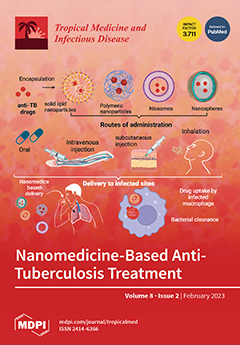Schistosomiasis is a helminth infection caused by the genus
Schistosoma, which is still a threat in tropical and sub-tropical areas. In the China, schistosomiasis caused by
Schistosoma japonicum is mainly endemic to the Yangtze River valley. The amphibious snail
Oncomelania hupensis (
[...] Read more.
Schistosomiasis is a helminth infection caused by the genus
Schistosoma, which is still a threat in tropical and sub-tropical areas. In the China, schistosomiasis caused by
Schistosoma japonicum is mainly endemic to the Yangtze River valley. The amphibious snail
Oncomelania hupensis (
O. hupensis) is the unique intermediate host of
S. japonicum; hence, snail control is a crucial approach in the process of schistosomiasis transmission control and elimination. In 2016, a nationwide snail survey was conducted involving all snail habitats recorded since 1950 in all endemic counties of 12 provinces. A total of 53,254 existing snail habitats (ESHs) were identified, presenting three clusters in Sichuan Basin, Dongting Lake, and Poyang Lake. The overall habitat area was 5.24 billion m
2, of which 3.58 billion m
2 were inhabited by
O. hupensis. The area inhabited by snails (AIS) in Dongting and Poyang Lakes accounted for 76.53% of the population in the country. Three typical landscape types (marshland and lakes, mountains and hills, and plain water networks) existed in endemic areas, and marshland and lakes had a predominant share (3.38 billion m
2) of the AIS. Among the 12 endemic provinces, Hunan had a share of nearly 50% of AIS, whereas Guangdong had no ESH. Ditches, dryland, paddy fields, marshland, and ponds are common habitat types of the ESH. Although the AIS of the marshland type accounted for 87.22% of the population in the whole country, ditches were the most common type (35,025 or 65.77%) of habitat. Six categories of vegetation for ESHs were identified. A total of 39,139 habitats were covered with weeds, accounting for 55.26% of the coverage of the area. Multiple vegetation types of snail habitats appeared in the 11 provinces, but one or two of these were mainly dominant. Systematic sampling showed that the presence of living snails was 17.88% among the 13.5 million sampling frames. The occurrence varied significantly by landscape, environment, and vegetation type. The median density of living snails in habitats was 0.50 per frame (0.33 m × 0.33 m), and the highest density was 40.01 per frame. Furthermore, two main clusters with high snail densities and spatial correlations indicated by hotspot analysis were identified: one in Hunan and Hubei, the other in Sichuan. This national survey is the first full-scale census on the distribution of
O. hupensis, which is significant, as transmission interruption and elimination are truly becoming the immediate goal of schistosomiasis control in China. The study discerns the detailed geographic distribution of
O. hupensis with the hotspots of snail density in China. It is beneficial to understand the status of the snail population in order to finally formulate further national control planning.
Full article






